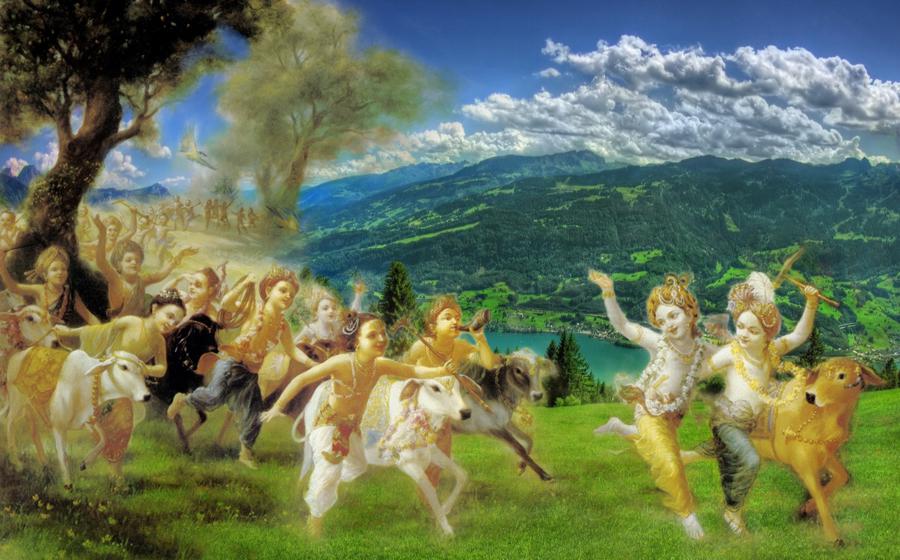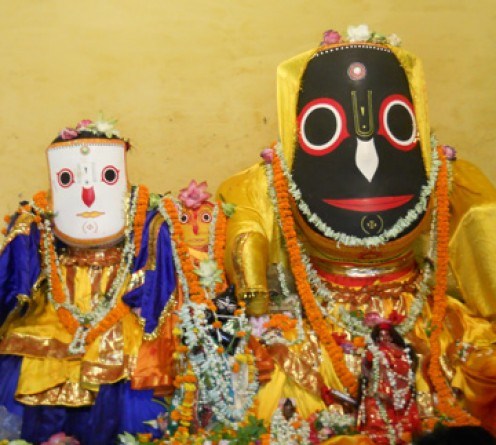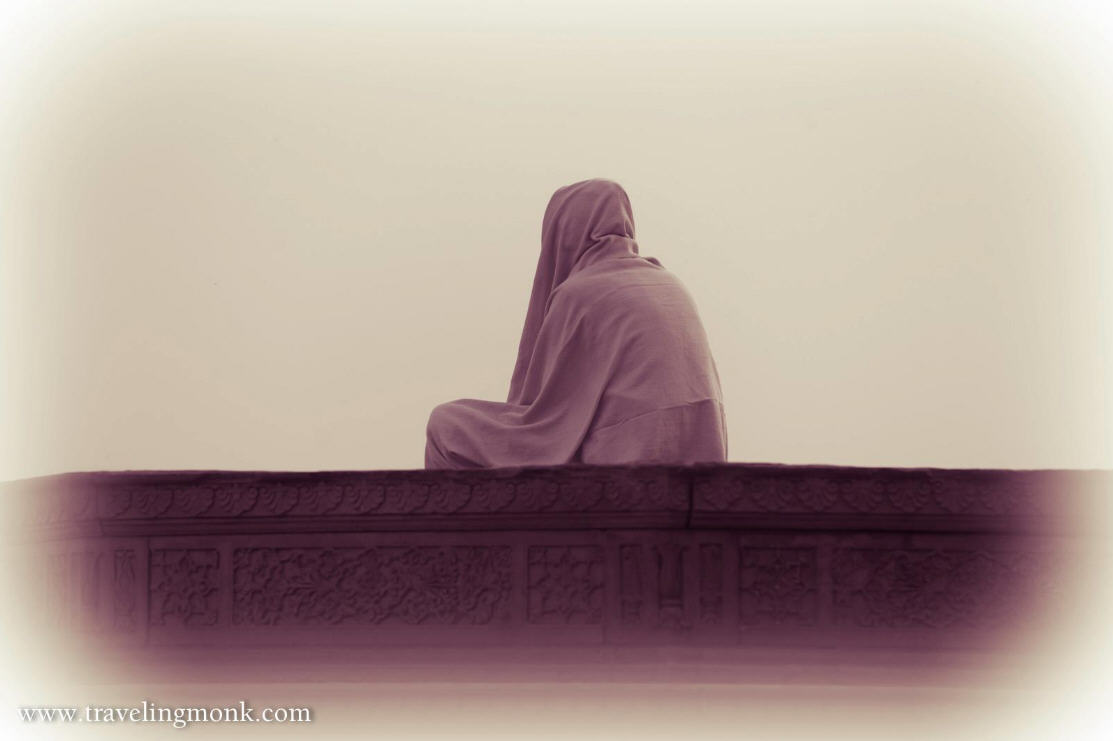kamalakarah pippalai-namnasid you mahabalah
Nityananda’s associate Kamalakara Pippalai was one of the twelve Gopals, formerly known as Mahabala.
(Gaura-ganoddesha-dipika 128)
Kamalakara’s behavior was extraordinary. It is well-known throughout the world that his love for Krishna is extraordinary.
(Chaitanya Charitamrita 1.11.24)

The cowherd boy who was known as Mahabala in Vrindavan is now known as Kamalakara Pippalai. Day and night he sang the glories of Radha and Krishna and is counted as one of Nityananda’s branches. He lived in Mahesha on the west bank of the Ganges where he served a Deity of Jagannath. (Vaishnavachara-darpana) (In the image: Krishna and Balarama with Their Friends).
The cowherd boy who was known as Mahabala in Vrindavan is now known as Kamalakara Pippalai. Day and night he sang the glories of Radha and Krishna and is counted as one of Nityananda’s branches. He lived in Mahesha on the west bank of the Ganges where he served a Deity of Jagannath. (Vaishnavachara-darpana)
Kamalakara Pippalai was born in Akna Mahesha and lived in Jageshvara. (Shripata-paryatana)
In the Gaudiya Vaishnava Abhidhana, Kamalakara’s birth year is given as 1492 AD. His father was a rich landlord. He was born in the village known as Khalijhuli in the Sundarbon area. He had a younger brother named Shrinidhipati Pippalai. They belonged to a Brahmin family of the Rarha branch.
Though born in Khalijhuli, he moved to the village of Mahesha, which is about 2 1|2 miles from the Serampore railway station in Hooghly. The famous Jagannath Deity in Mahesha was consecrated by him. Prior to Kamalakara’s arrival, the area around Mahesha was nothing but jungle, but he had the land cleared and made into a model village whose fame spread everywhere.
Shrila Bhaktisiddhanta Saraswati Goswami Thakur has told two stories about Kamalakara Pippalai in his Anubhashya to the Chaitanya-charitamrita:
(1) When Kamalakara Pippalai left home his younger brother Nidhipati Pippalai searched for him and in due course of time found him in the village of Mahesha. When his brother refused to return despite his remonstrances, Nidhipati Pippalai came to live in Mahesha with all his family members. His descendants still reside in the Mahesha area, where they consist of some twenty households.
(2) There was once a vairagi named Dhruvananda who went on pilgrimage to Puri. It was his strong desire to offer Lord Jagannath food that he had cooked with his own hands. Jagannath appeared to him in a dream one night and told him to go to Mahesha on the the Ganges and when Jagannath was installed there, his wish to cook and make an offering to him would be fulfilled. When Dhruvananda came to Mahesha, he saw Jagannath, Balaram and Subhadra floating in the Ganges. He picked them out of the water and had a small hut built where he could shelter and worship them. As he neared his death and was searching about for a suitable replacement for himself to take care of the Deities, Jagannath once again appeared to him in a dream and said, "My Devotee, a great Vaishnava named Kamalakara Pippalai, lives in the village of Khalijuli in the Sundarban. I have ordered him in a dream to come here and take over My service. When he comes, you should turn the responsability for caring for Me over to him.
The next morning, Kamalakara Pippalai, who had indeed had such a dream, arrived there and Dhruvananda immediately gave him charge of the worship of Jagannath, Baladeva and Subhadra. Having been empowered in this way to serve the Lord, Kamalakara Pippalai took the title Adhikari, and this title has been used as the family name ever since. The Pippalai name belongs to one of the fifty-five branches of the Rarha Brahmins."

There was once a vairagi named Dhruvananda who went on pilgrimage to Puri. It was his strong desire to offer Lord Jagannath food that he had cooked with his own hands. Jagannath appeared to him in a dream one night and told him to go to Mahesha on the the Ganges and when Jagannath was installed there, his wish to cook and make an offering to him would be fulfilled. When Dhruvananda came to Mahesha, he saw Jagannath, Balaram and Subhadra floating in the Ganges. He picked them out of the water and had a small hut built where he could shelter and worship them. As he neared his death and was searching about for a suitable replacement for himself to take care of the Deities, Jagannath once again appeared to him in a dream and said, "My Devotee, a great Vaishnava named Kamalakara Pippalai, lives in the village of Khalijuli in the Sundarban. I have ordered him in a dream to come here and take over My service. When he comes, you should turn the responsability for caring for Me over to him. (In the image: Jagannath, Baladeva and Subhadra Mayi, Mahesha).
The Devotee is always anxious to serve the Lord, so the Lord gives him directions for service, and never to a non-devotee. Kamalakara was gratified to have received Lord Jagannath’s order, and immediately abandoned his home and family to go to Mahesha. The conditioned souls are normally so attached to the pleasures of their gross and subtle senses that the mere mention of service to Krishna and the Vaishnavas fills their hearts with fear. They consider it to be a burden and look for any excuse to avoid such service. Because it does not contribute to the gratification of the senses, they do not consider service to Vishnu and the Vaishnavas to be a wealth or a source of profit in the way that a Vaishnava does. To the eyes of the world, a Vaishnava may be playing the role of a family man, but he is not of the same order as a worldly householder. Sometimes it is the Lord’s wish that someone take a wife and have a family, but even though he is externally subject to the same conditions that an ordinary materialists because his mind is absorbed in separation from the Lord. Thus, as soon as he receives direction from the Lord, he enthusiastically abandons his material connections and becomes fully engaged in the Lord’s service. This renunciation of family life is not painful as it is for one on the jnana-yoga path, but is natural and spontaneous.
The Vijaya-khanda says that Nityananda gave Panihati over to Kamalakara.
Shrila Bhaktisiddhanta Saraswati Goswami Thakur has noted a few of the generations which descended from Kamalakara. He had a son named Chaturbhuja, who in turn had two sons, Narayan and Jagannath. Narayan’s son was named Jagadananda whose son was Rajivalochana. During Rajivalochana’s lifetime, service to the Jagannath Deity was at first hampered by a shortage of finances. The Nawab of Òhaka, Wali Shah Suja, donated 1185 bighas of land in the Bengali year 1060 (1653 AD). This land is found in the area of Jagannathpura, about 2 1/2 kroshas from the Mahesha Temple. The village was named Jagannathpura after the Deity.
The Gaudiya Vaishnava Abhidhana cites the following verses from Nityananda-vamsha-vistara:
A pure-hearted Brahmin who regularly worshiped Vishnu and the Vaishnavas lived in the town of Mahesha. He was Pippalai’s son-in-law named Sudhamaya. His wife was Vidyunmala.
Thus, Vidyunmala, Kamalakara Pippalai’s daughter, married Sudhamaya Chattopadhyaya. They had a daughter named Narayani Devi. Virabhadra Prabhu later married this Narayani Devi. The descendants of the Pippalai family in Mahesha say that this girl’s name was Radharani. On the other hand, Shrila Bhaktisiddhanta Saraswati Goswami Thakur has said that Virabhadra Prabhu married Shrimati, who was the daughter of Yadunatha Acharya and his wife Vidyunmala, as well as their adopted daughter, Narayani.
The Vaishnavacara-darpana also states that a highly qualified Brahmin named Yadunandana was married to Kamalakara Pippalai’s daughter Vidyunmala. Yadunandana thus had a great Devotee of Jagannath, who knew nothing but the desire to serve Jagannath, as his father-in-law.
Kamalakara was present in Panihati at the Danda-mahotsava of Raghunath Das. He also came to the renowned festivals at Kheturi and Katwa. He joined Jahnava Devi to got here, as his name is mentioned in this connexion in Bhakti-ratnakara (10.375).
According to the Vaishnavacara-darpana, he left for Vrindavan after giving his daughter away in marriage where he lived until the end of his days. According to the tradition maintained by his descendants, the disappearance day of the founder of their line was Chaitri Shukla-trayodashi of the year 1563 AD.
[Excerpted from “Shri Chaitanya: His Life & Associates” by Shrila Bhakti Ballabh Tirtha Maharaj]

To the eyes of the world, a Vaishnava may be playing the role of a family man, but he is not of the same order as a worldly householder. Sometimes it is the Lord’s wish that someone take a wife and have a family, but even though he is externally subject to the same conditions that an ordinary materialists because his mind is absorbed in separation from the Lord. Thus, as soon as he receives direction from the Lord, he enthusiastically abandons his material connections and becomes fully engaged in the Lord’s service. This renunciation of family life is not painful as it is for one on the jnana-yoga path, but is natural and spontaneous. (In the image: Shri Vrindavan Dham).


